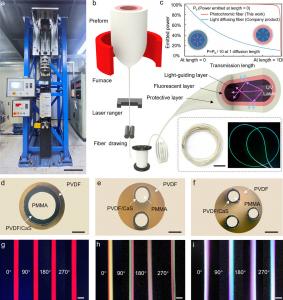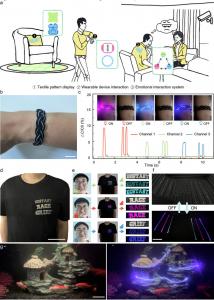Multicolor Photochromic Fibers Deliver Interactive Wearable Displays
USA, April 5, 2024 /EINPresswire.com/ -- Empowering flexible fibers with light-emitting capabilities has the potential to revolutionize the current design philosophy of smart wearable interactive devices. Here, Chinese scientists introduce a photochromic fiber that provides uniform multicolor light control, enabling uniformity of light emission along the transmission direction and spectral radiation in multiple color systems from a single fiber. This fiber can be directly integrated into daily clothing, providing new perspectives and inspirations to the existing field of fiber display interaction.
Fiber, as the wearable material with the longest application in the history of humankind, is currently an ideal substrate for wearable devices due to its excellent breathability, flexibility, and ability to adapt perfectly to the 3D irregular shape of the human body. As a means of visualization in the field of functional fibers, light-emitting fiber breaks the rigidity of the traditional display interface and is expected to become an emerging interaction interface. The current commercial light-emitting fibers are polymer optical fibers and Corning® Fibrance® light-diffusing fibers. These fibers utilize artificial grooves or air gaps to disrupt total internal reflection conditions, thus actively inducing light leakage. However, the brightness uniformity in the transmission and the circumferential direction cannot be guaranteed due to transmission losses and artificial defects, significantly limiting their application as line light sources.
In a new paper (https://doi.org/10.1038/s41377-024-01383-8) published in Light Science & Applications, a team of scientists, led by Professor Guangming Tao from Huazhong University of Science and Technology, and Professor Yan-Qing Lu from Nanjing University have achieved a highly flexible, uniformly luminescent photochromic fiber based on a mass-producible thermal drawing method. The team utilized fluorescent materials on polymer optical fiber to regulate its external radiation spectrum and achieve uniform luminescence through the saturation effect. They also achieved wide color gamut control in a single fiber by optimizing the fiber structure to mix the RGB primary colors. The research team integrated the controllable photochromic fibers into various wearable interactive interfaces, which realized diversified interactions such as emotion and communication by using daily clothes and provided a new way to realize human-computer interaction. It is expected to bring new changes to the human lifestyle in communication, navigation, healthcare, wearables, and the Internet of Things.
Benefiting from the structural designability and diversified regulation of composite preforms, the authors use polymethyl methacrylate material as the inner light-guiding layer and integrate fluorescent composite material with a lower refractive index in the outer layer. This coaxial structure allows for total internal reflection of light within the fiber while utilizing the wavelength conversion effect of the fluorescent material to achieve a uniform and comprehensive light emission. At the same time, following the principle of RGB color mixing, multiple light-guiding core layers and fluorescent materials with different colors are encapsulated inside a single fiber to realize the regulation of a multicolor system. Finally, the physically and chemically stable PVDF materials are integrated into the outside of the fiber to achieve the sealing and protection of the functional materials.
“The photochromic fiber we designed mainly overcomes the existing light-emitting fibers in three aspects of the defects: (1) achieving uniform and comprehensive light emission by utilizing the wavelength conversion effect of the fluorescent material. (2) Taking advantage of the characteristics of multiple waveguide core layers within a multicore fiber that can be individually controlled in segments and achieve a wider color gamut range regulation in a single fiber by modulating the brightness of the light source in the coupled core layers. (3) Hundred meters preparation based on the industrial thermal drawing process overcoming the shortcomings of traditional luminescent fiber preparation such as long cycle time, short effective length, and high preparation cost.”
“The high production efficiency of photochromic fibers facilitates meeting the substantial demand for textile industrial supply. These fibers can be easily incorporated into various daily wear through sewing and knitting techniques, providing a novel approach to achieving flexible wearable interactive interfaces. We try to integrate it into multiple wearable interaction scenarios to demonstrate the feasibility of photochromic fibers as an auxiliary communication technology tool and also provide a new way of thinking for the multimodal integration of smart textiles. Without raising privacy concerns, this breakthrough could open up new areas for future smart cities, smart homes, human-computer interfaces, and health monitoring.” The scientists predicted.
DOI
10.1038/s41377-024-01383-8
Original Source URL
https://doi.org/10.1038/s41377-024-01383-8
Funding information
This work was supported by the National Natural Science Foundation of China (Grant No. 62175082), the National Key Research and Development Program of China (Grant No. 2022YFB3805800), and the Multidisciplinary Research Support Program of Huazhong University of Science and Technology (Grant No. 2023JCYJ039).
Lucy Wang
BioDesign Research
email us here
Legal Disclaimer:
EIN Presswire provides this news content "as is" without warranty of any kind. We do not accept any responsibility or liability for the accuracy, content, images, videos, licenses, completeness, legality, or reliability of the information contained in this article. If you have any complaints or copyright issues related to this article, kindly contact the author above.


